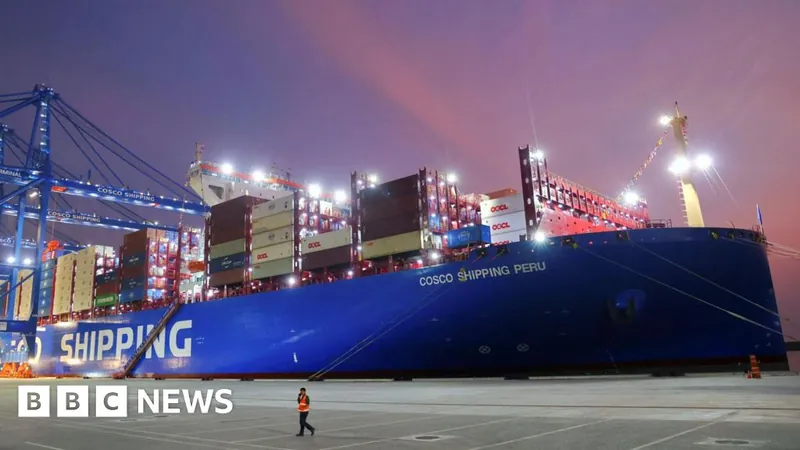
America's Hotbed: China's New Megaport Ignites Tensions in Latin America
2024-11-15
Author: Ting
Geopolitical Tensions Rise in Latin America
As the spotlight returns to the political chess game between Washington and Beijing amid Donald Trump's unexpected resurgence, China's strategic maneuvers in Latin America continue to unfold. The recent inauguration of the Chancay megaport on the Peruvian coast has caught the world's attention, marking a pivotal moment in trade dynamics that could radically reshape the region's economic landscape.
With Trump, who once championed tariffs as high as 60% on Chinese imports during his presidential campaign, reemerging into American politics, the geopolitical stakes have never been higher. This new Chinese-backed megaport signals the possibility of new trade routes that could bypass North America entirely, posing a direct challenge to U.S. influence in the Americas.
Chancay Megaport's Implications for Trade
The Chancay port, an ambitious $3.5 billion project developed by China’s state-owned Cosco Shipping, transforms a previously unremarkable Peruvian fishing village into a critical logistical hub. China's President Xi Jinping attended the port's inauguration during the Asia-Pacific Economic Co-operation Forum (Apec), underscoring the significance of this development not just for Peru but also for China's expanding presence in Latin America—traditionally seen as America's backyard.
Analysts are raising alarms about the implications of this new trade route. Monica de Bolle, a senior fellow at the Peterson Institute for International Economics, emphasized that the U.S. has neglected Latin America long enough to allow China to move in rapidly. 'The balance of power is shifting, and America must respond before it’s too late,' she warns.
Operational Benefits of Chancay Port
Once operational, Chancay is set to facilitate the movement of goods from other South American nations, including Brazil, Chile, Colombia, and Ecuador, directly to Asian markets. This will not only streamline trade but also cut shipping times significantly—from 35 to just 23 days—while also accommodating larger container vessels. This capability falls in line with China's appetite for Latin American exports, particularly in commodities like Brazilian soybeans and Chilean copper.
Local Industry Concerns and U.S. Military Unease
However, the ramifications of the port's construction extend further, as increasing imports of inexpensive Chinese goods threaten to undermine local industries. As a result, both Chile and Brazil have started rolling back tax exemptions on low-value foreign purchases, showcasing their growing concern over domestic competition.
Moreover, U.S. military officials are expressing unease over the dual-use potential of the Chancay port. General Laura Richardson, former chief of U.S. Southern Command, highlighted fears that the port could one day serve as a logistical center for the People’s Liberation Army, further complicating the U.S.'s position in the region.
Peru's Perspective and U.S. Engagement
Peru's President Dina Boluarte hailed the megaport as a transformative 'nerve center' for connecting to the vast Asian markets. Yet, commentators note that the overall influence of the U.S. in Latin America is in jeopardy, particularly in light of President Biden's relatively muted engagement during the recent Apec summit compared to China's proactive approach.
Growing Chinese Presence in Latin America
China's presence in Latin America is growing at a fast pace, and while there are challenges associated with some of Beijing's infrastructure projects—many of which have left developing nations with burdensome debt—numerous governments are beginning to prioritize their economic partnerships with China over historical ties with the U.S.
Navigating U.S.-China Rivalry
As the geopolitical game intensifies, the Latin American nations must navigate the tricky waters of U.S.-China rivalry carefully. Many countries are keen not to be forced into making a binary choice between the two superpowers, especially as post-election dynamics in the U.S. remain uncertain.
Experts suggest that a more cohesive regional strategy is required to ensure that Latin America can engage with both powers on its own terms. While the U.S. is still viewed favorably by many in the region, Eric Farnsworth of the Council of the Americas emphasizes that the U.S. must offer a meaningful alternative to remain competitive against Chinese interests.
Conclusion: The Future of U.S.-Latin America Relations
In the upcoming years, as Latin America walks the delicate line between the ambitions of Washington and Beijing, all eyes will be on how these relations unfold. Will the U.S. step up to meet the needs of its southern neighbors, or will China’s mega-infrastructure projects redefine the power dynamics in the Western Hemisphere? The next chapter of this geopolitical saga is just beginning, and the world is watching intently.


 Brasil (PT)
Brasil (PT)
 Canada (EN)
Canada (EN)
 Chile (ES)
Chile (ES)
 España (ES)
España (ES)
 France (FR)
France (FR)
 Hong Kong (EN)
Hong Kong (EN)
 Italia (IT)
Italia (IT)
 日本 (JA)
日本 (JA)
 Magyarország (HU)
Magyarország (HU)
 Norge (NO)
Norge (NO)
 Polska (PL)
Polska (PL)
 Schweiz (DE)
Schweiz (DE)
 Singapore (EN)
Singapore (EN)
 Sverige (SV)
Sverige (SV)
 Suomi (FI)
Suomi (FI)
 Türkiye (TR)
Türkiye (TR)